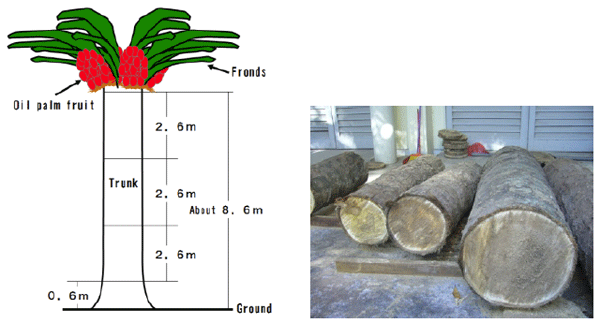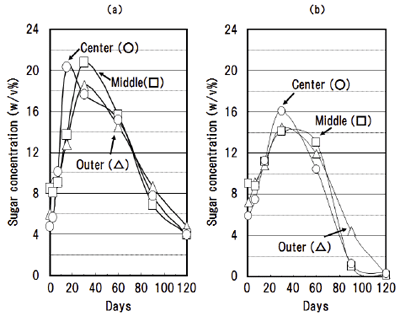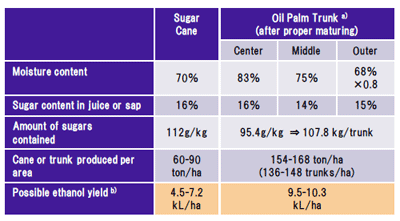Potential of old oil palm trunks as feedstock for Bioethanol
Description
According to the statistical data of the US Department of Agriculture (USDA, 2005), palm oil, a major edible vegetable oil along with soybean oil, is produced at 3.5 million tons per year. Oil palm trees have an economic life span of approximately 20-25 years, after which old trees are felled and replanted. Although some portions of the old felled trunks are utilized for plywood manufacturing, almost all of the other parts have no practical way of utilization and have become troublesome wastes.
In an attempt to develop a method for utilizing old oil palm trunks for the production of fuel ethanol and usable materials, we discovered that the felled oil palm trunks contain large quantities of sap and that abundant glucose and other fermentable sugars exist in the sap. Most significantly, the amount of fermentable sugars is nearly 10% in the sap collected from the inner parts of the trunk. To understand the mechanism of sugar accumulation in the trunks, the moisture and sugar contents were analyzed using sap collected from an oil palm trunk which was sliced at each 0, 1, 7, 15, 30, 60, 90, and 120th day.
Surprisingly, the total sugar contents of the sap were drastically increased from 18.5% to 20.7% by storage for 30 to 60 days, although the moisture content of the trunk did not change during the total storage period. In addition, the fermentable sugars such as glucose, sucrose, and fructose contained in the sap were also increased by a maximum of 16.1% during the storage period of 30 to 60 days. These results indicate that the concentration of fermentable sugars in the trunk is able to be drastically increased within a suitable storage period. If oil palm trunks are processed within a suitable maturing or storage period, there is the possibility to produce ethanol in quantities ranging from 9.5 to 10.3 kL/ha from oil palm trunks, whereas only 4.5 to 7.2 kL/ha from sugarcane. Thus, the discarded old oil palm trunks that used to be troublesome and caused serious environmental pollution have the huge potential to become sustainable useful biomass resources rivaling sugarcane.
Figure, table
-
Fig. 1. Cutting and storage (maturing) tests of old oil palm trunks.
Cross-section diagram of an oil palm trunk (left). Storage test of felled oil palm trunks (right). Diameter of the trunks varies from 30 to 60 cm. -
Fig. 2. Variation of total and fermentable sugars in the sap from old oil palm trunks during storage period.
The sugar concentration was measured using phenol-sulfuric acid method and HPLC (High Performance Liquid Chromatography) analysis. Labels (a) and (b) indicate concentrations of total sugar and fermentable sugars, respectively. Symbols: ◯ - center part, □ - middle part; △ - outer part. -
Fig. 1. Cutting and storage (maturing) tests of old oil palm trunks.
Cross-section diagram of an oil palm trunk (left). Storage test of felled oil palm trunks (right). Diameter of the trunks varies from 30 to 60 cm
- Affiliation
-
Japan International Research Center for Agricultural Sciences Post-harvest Science and Technology Division
- Term of research
-
FY2008(FY2006~2011)
- Responsible researcher
-
KOSUGI Akihiko ( Post-harvest Science and Technology Division )
MURATA Yoshinori ( Post-harvest Science and Technology Division )
ARAI Takamitsu ( Post-harvest Science and Technology Division )
MORI Yutaka ( Post-harvest Science and Technology Division )
TANAKA Ryohei ( Forestry and Forest Products Research Institute )
YAMADA Hajime ( University of Tokyo )
- ほか
- Publication, etc.
-
Kosugi et al. Japanese Patent Application No. 2008-109229. "How to collect sap from palm trunk"
Mori, Y. (2008) 5th Biomass-Asia Workshop, Guangzhou, China.
Kosugi et al. Japanese Patent No. 4065960. "Method for producing ethanol and lactic acid"
- Japanese PDF
-
2008_seikajouhou_A4_ja_Part18.pdf587.33 KB



